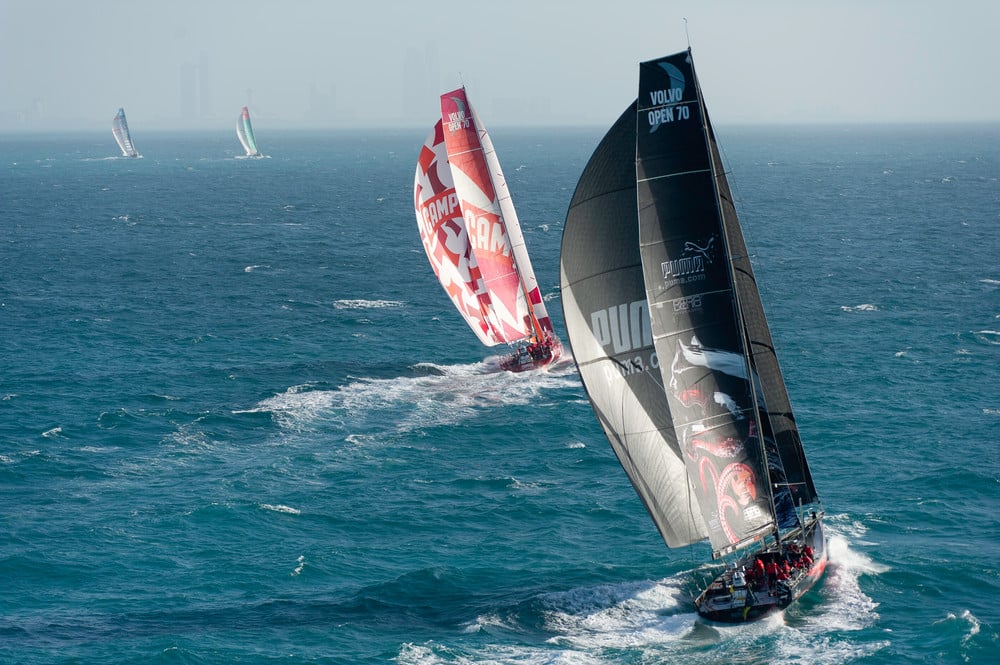
RyanODhabi960
Ryan O’Grady, a veteran follower of the Volvo Ocean Race and a top amateur sailor, is providing regular insight and analysis on the 2011-’12 Volvo Ocean Race for SailingWorld.com. To get the full picture of this dynamic race, follow the racing in our Finish Line forum, track the fleet, and catch up on the race with O’Grady’s previous Volvo Voyeur blogs.
Following a final sprint to Abu Dhabi, Leg 2 of the Volvo Ocean Race is now in the books. In case you missed it, Groupama won the 100-mile finale, passing Puma, Telefonica, and CAMPER/ETNZ in the final miles to take their first victory of the race. Overall, Telefonica won the combined Leg 2, with Camper in second, Puma in third, Groupama fourth, and Abu Dhabi fifth. Team Sanya has resumed racing after a rigging repair left them marooned in Madagascar for about three weeks. Sanya has about a week to make it to the “secret location” to get scoring credit for all of Leg 2, and Leg 3A.
Here’s what I’ve taken away from this crazy leg:
**
1. The Format Is Absurd.** I’ve said it before, and I’ll say it again: this was the best leg we never saw. With the fleet separated by less than 100 miles entering the Stealth Zone, it was anyone’s race. With a “Secret Finish Port” located just beyond the northern ridge of the Doldrums, major drama was inevitable. Unfortunately for all of us following the race, the restrictions of the Stealth Zone meant we couldn’t really track the fleet or see how each boat was positioning itself to deal with the weather. What’s worse, we have to deal with this same restriction again for the start of Leg 3. Race management squandered a huge opportunity here. Instead of finishing at some secret port, why not put the intermediate stop in India, embrace it, and make a “pit stop” out of it? The last edition of the race had a wildly successful stopover in India, the sponsors would have received additional free exposure, and we all would have a race to watch. Maybe next time, Volvo…
**
2. Don’t Make Any Performance Predictions…Yet.** Over the course of Leg 2, every boat held the lead at least one. Every boat also took its turn in last place. The ability to manage currents and clouds dictated the much of the finish order. Puma and Groupama could easily have been first and second, had they not sailed under a cloud that the boats behind them were able to sail around. The boys on CAMPER/ ETNZ must be wondering what they need to do to preserve a lead—twice in Leg 2 with the finish in sight, a Juan K-designed boat flat-out passed them. CAMPER’s Botin-designed boat does appear to have pace in most wind conditions, and being consistently near the top is certainly a good place to be. On the other end of the fleet, Ian Walker has been recently defending his Farr-designed boat, Azzam. In discussing Abu Dhabi Ocean Racing’s Leg 2 performance, Walker said, “Differences can be very subtle on these boats. Another few degrees different wind angle, and we could have been the fastest boat out there. The longer you have sailed against each other in close proximity, the more you learn about how to mode, trim, and sail your boat fast, and the better you are going to get at all that.”
**
3. Reliability Matters. **The Volvo Ocean Race is a 39,000-mile marathon. As in any test of endurance, things are bound to fail. Abu Dhabi Ocean Racing learned this the hard way just hours into Leg 1 when their mast broke due to rigging failure. While originally considered to be a freak accident, when Team Sanya suffered identical rigging failure in Leg 2, it was clear the boats’ rigging wasn’t properly engineered. Both boats started the race with a new, continuous carbon rigging package manufactured by Future Fibres. In a continuous rigging solution, all of the shrouds and diagonals are formed into a single piece of carbon rod. This solution has slightly lighter weight and windage than a more traditional discontinuous solution (Southern Spars Element C6, for example), where each piece of rigging is a separate piece with its own terminations. Discontinuous carbon rigging is a more time-tested solution than continuous rigging, and has the added ability of being easier to replace in remote parts of the world. If a piece of rigging fails, only the broken part needs to be fixed. When Team Sanya’s rigging broke, Future Fibres need to build a whole new rigging assembly, which took weeks. Since the solution is also a one-piece assembly, final cure of the carbon rigging could only be done after the rigging was assembled, taking even more time away from a team desperate to get back into the race. Abu Dhabi realized these potential disadvantages and completely changed their rigging solution to a discontinuous model during their shipment to Cape Town on Leg 1. Team Sanya didn’t have the luxury of making this change, since they were busy grafting a new bow section onto their boat. It will be interesting to see if they also make a rigging change in a future port.
Racing in Abu Dhabi resumes this weekend with the In-Port Race scheduled for Friday and the Leg 3 Sprint start scheduled for Saturday. Early risers can catch the action live on the race’s Livestream site. Leg 3 will follow a similar format to Leg 2, with the fleet racing about 100 miles to the cargo ship. The winner of that portion will get 6 points. The real Leg 3 will begin about a week later from the “Secret Location” someplace in the Indian Ocean. From there, it will be 4000 miles of racing through the Indian Ocean to Sanya, China. Expect a lot of light-air sailing and a ton of lead changes, as the leg route runs through mainly equatorial waters.









